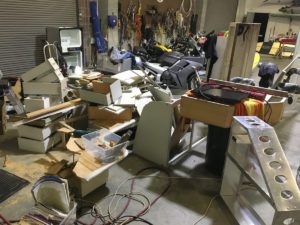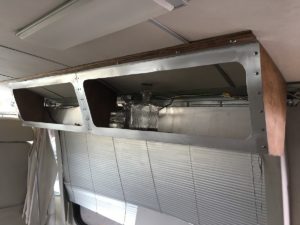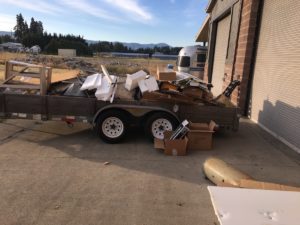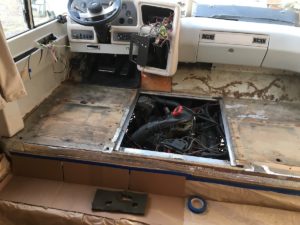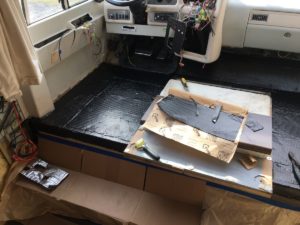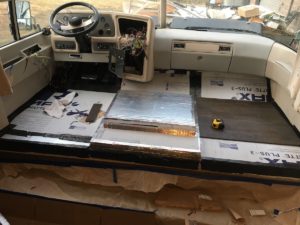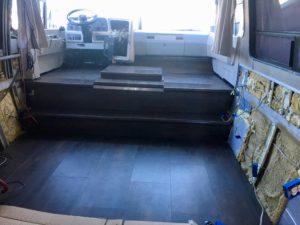Fritz: The Vandal Strikes
Several people emailed me, saying that they thought the interior is great. They should come get it before I haul it to the dump. I don’t mean to sound cruel, but it just isn’t what we want. My goal is pretty simple: Have a nice bedroom, a usable and simple kitchen, and a space that’s pleasant to be in. I know massive built-ins are the standard for RV’s but that isn’t my style. Even more important, it isn’t Diane’s So we’re aiming for light, open, airy, and beautiful.
Instead of Corian counter tops I’m using honeycomb aluminum panels with laminate tops. Each shelf and counter will weigh about 45 pounds less than the ones they replace. The aim is not just weight reduction, it’s safety and appropriate materials. In an accident a Corian countertop becomes a 60-pound frisbee headed for the front window. I can adequatly and solidly fix a ten-pound honeycome aluminum top, I’m not sure I could do that to the Corian. I can say for certain that the way they were fastened in the original interior served only to keep them from falling to the floor. I’m surprised the table survived hard braking.
Here’s the parts of the interior that I considered potentially worth salvaging, or that I needed to make measurements before ditching. And the aluminum thing in the foreground is the slide-in pantry shelf I built to replace that massive wooden structure on it’s side behind it. The original weighed 45 pounds, it’s replacement is less than five.
Click any picture to see full size.
That tall, narrow cabinet standing in the background is one of the many overhead cabinets. That one weighed 45 pounds–3/4″ plywood and MDF.
And this is a cabinet I built to replace it. About six pounds with the end caps. I made it from a single piece of .040″ aluminum, just bent the panel to form the mounting flanges, front, bottom and back. It screws into tapped holes in the extruded aluminum frame of the coach. A very strong mount. The opening will be guarded by three carbon fiber rods that can be slid aside. Across the cabin will be two similar cabinets, deeper, and with sliding doors.
I’m also ditching the propane system. This will be all electric, with a big LiFePO4 battery and solar panels. I’ve insulated the floor and walls carefully with Polyiso panels and Reflectix. We’ll see how that goes, but carrying a huge weight of propane for the light heating and refrigeration load of an RV doesn’t seem like the best idea. I’m installing a compressor refrigerator to replace the absorption one. The electrical draw is surprisingly low. I’ll cover all that later. I’ve calculated likely air conditioning, heating, cooking and lighting loads. It looks a bit marginal for hot or cold weather if we’re not plugged in to shore power, but it should be enough for two days without sun. And we do have a 5.5 KW Onan genset, though I’d like to minimize using that.
Here’s the trailer headed for the dump.
We also aim to have open space, and NO Shag Carpet. We’re using a high-end locking edge vinyl tile for the floors. If a tile gets damaged, the floor tiles can be lifted to replace the damaged tile.
Here’s the cab with the skanky shag carpet ripped out.
Sound deadening material installed (that big 455 engine is loud).
Thermal insulation installed–Polyiso and Reflectix.
And the finished floor.
Enough typing, time to get back to work.
